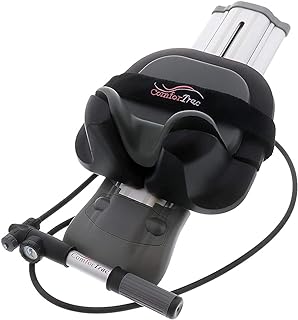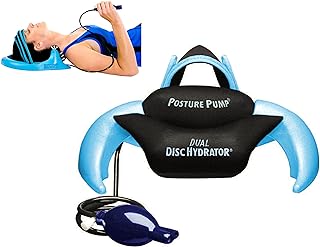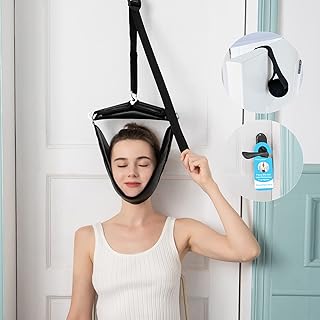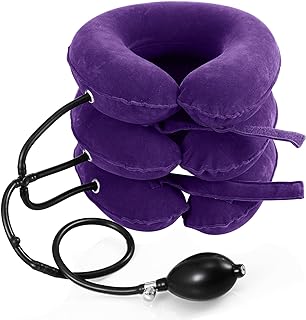Home Cervical Traction Units
Before considering specific cervical traction devices, it may be useful to review the general rationale for spinal traction and the conditions that these units are most likely to help.
When traction forces are applied to the spine there is usually some drop in pressure within the spinal discs - the fibrocartilage spacers between each of the spinal bones (vertebrae). This can help reduce disc bulges and herniations as well as relieve pressure on other spinal joint structures and help with associated neck and upper back pain due to cervical disc/joint problems or lower back pain due to lumbar disc/joint problems. In some cases this can also reduce pressure on the nerves that travel between each of these vertebrae and help decrease associated symptoms such as pain, numbness or tingling that radiates into one or both arms due to cervical disc/joint problems or down one or both legs due to lumbar disc/joint problems.
People with spinal disc degeneration ("degenerative disc disease") may also benefit from a traction based treatment as this may be helpful in improving the flow of nutrients to the discs. Some providers feel that this may slow down the course of degeneration over time. For this reason, there may be some preventive value to this application also.
Although spinal traction devices may be of significant benefit to some people, it is important not to "self diagnose" as individual requirements vary and what may be a great management option for one condition may be a bad choice for another. Assuming you have had appropriate testing by a qualified provider and any necessary professional treatment for your particular condition, you have discussed how appropriate a home traction unit would be in your particular case and in was determined that you are a good candidate for such a device, I hope you find my review of the following products helpful.
Although more expensive than the other products on this page, I believe this type of unit is by far the best device for providing cervical traction at home for the money. This provides cervical traction in the supine position (lying down, facing up) allowing more complete relaxation of postural muscles that can limit the effect of units that provide cervical traction in the upright position. Short of a professional unit that allows preset intermittent traction protocols (at many times the price), I believe this to be one of the best choices available for a home traction unit and the one I would personally pick for this purpose.
This unit is a little bit different in it's approach but still an effective method for certain conditions. Instead of true "axial traction" this works by extending the neck backwards in such a way as to decrease cervical disc pressure and help with conditions such as herniated and degenerated discs as well as potentially improving the natural backwards curvature ("lordosis") of the cervical spine. This unit is also used in the supine position (lying facing up) - the preferred method of cervical traction, as noted above. However, a condition that is not likely to be helped with this unit is spinal stenosis and I would not recommend it for that purpose.
No list of cervical traction units would be complete without including an "over the door" model. These have been around for a long time and, although they have their limitations, they can still be useful for some people. The bad: as noted above, cervical traction in the sitting position is not ideal, the neck muscles to not relax in the same way that they do when lying down and this limits the effectiveness of the unit to some degree which unfortunately cannot be overcome by simply increasing the amount of the pull. I am also not a fan of units that require straps to be under the chin as this can be potentially aggravating for certain dental and TMJ problems. The good: very inexpensive compared to some other options and may be "good enough" to help some people.
I will start by saying that I am not a huge fan of these types of units. The degree of traction that this product can provide is limited and the fact that it may apply some pressure to arteries in the neck concerns me - I would not recommend this to anyone that may have compromised arteries (such as cartotid blockage). However, as this unit can be helpful in providing some relief of pain associated with cervical disc problems and irritated joints in the neck, along with the fact that it is very inexpensive compared to some other options, it may be useful for some people. I believe the most likely to benefit from this device are people of average or smaller size. Taller people and those with a very thick neck would probably be less likely to find this product useful and may have a greater chance of neck compression rather than the desired traction effect. To ensure safety, I would encourage someone considering this device to discuss with their health care provider how appropriate this may be in their particular case.




